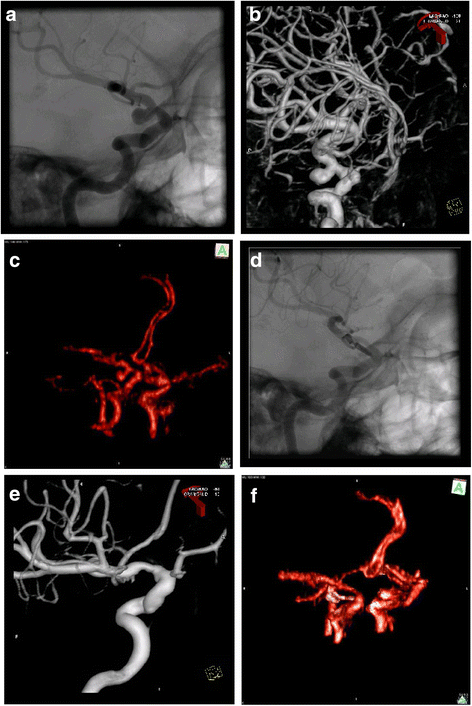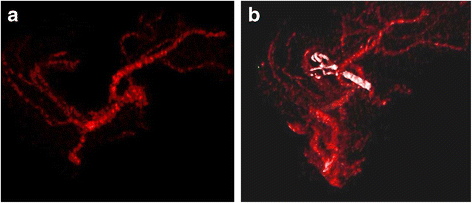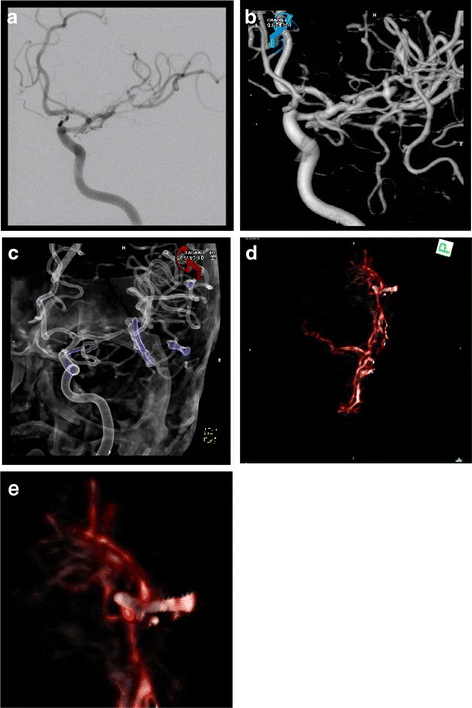3D rotational fluoroscopy for intraoperative clip control in patients with intracranial aneurysms--assessment of feasibility and image quality
- PMID: 27094510
- PMCID: PMC4837534
- DOI: 10.1186/s12880-016-0133-0
3D rotational fluoroscopy for intraoperative clip control in patients with intracranial aneurysms--assessment of feasibility and image quality
Abstract
Background: Mobile 3D fluoroscopes have become increasingly available in neurosurgical operating rooms. In this series, the image quality and value of intraoperative 3D fluoroscopy with intravenous contrast agent for the evaluation of aneurysm occlusion and vessel patency after clip placement was assessed in patients who underwent surgery for intracranial aneurysms.
Materials and methods: Twelve patients were included in this retrospective analysis. Prior to surgery, a 360° rotational fluoroscopy scan was performed without contrast agent followed by another scan with 50 ml of intravenous iodine contrast agent. The image files of both scans were transferred to an Apple PowerMac® workstation, subtracted and reconstructed using OsiriX® free software. The procedure was repeated after clip placement. Both image sets were compared for assessment of aneurysm occlusion and vessel patency.
Results: Image acquisition and contrast administration caused no adverse effects. Image quality was sufficient to follow the patency of the vessels distal to the clip. Metal artifacts reduce the assessability of the immediate vicinity of the clip. Precise image subtraction and post-processing can reduce metal artifacts and make the clip-site assessable and depict larger neck-remnants.
Conclusion: This technique quickly supplies images at adequate quality to evaluate distal vessel patency after aneurysm clipping. Significant aneurysm remnants may be depicted as well. As it does not require visual control of all vessels that are supposed to be evaluated intraoperatively, this technique may be complementary to other intraoperative tools like indocyanine green videoangiography and micro-Doppler, especially for the assessment of larger aneurysms. At the momentary state of this technology, it cannot replace postoperative conventional angiography. However, 3D fluoroscopy and image post-processing are young technologies. Further technical developments are likely to result in improved image quality.
Keywords: 3D fluoroscopy; Aneurysm surgery; Angiography; Clip control; Contrast; Image quality; Intraoperative; Post-processing; Vessel patency.
Figures



Similar articles
-
Intraoperative cerebral angiography by intravenous contrast administration with 3-dimensional rotational fluoroscopy in patients with intracranial aneurysms: a feasibility study.Neurosurgery. 2015 Mar;11 Suppl 2:119-26; discussion 126. doi: 10.1227/NEU.0000000000000648. Neurosurgery. 2015. PMID: 25599196
-
Optimization of radiation settings for angiography using 3D fluoroscopy for imaging of intracranial aneurysms.Comput Assist Surg (Abingdon). 2021 Dec;26(1):22-30. doi: 10.1080/24699322.2021.1894240. Comput Assist Surg (Abingdon). 2021. PMID: 33689512 Clinical Trial.
-
Safety and Feasibility Assessment of the O-Arm as an Intraoperative Angiography Device in Aneurysm Surgery.World Neurosurg. 2019 Jul;127:e1159-e1165. doi: 10.1016/j.wneu.2019.04.076. Epub 2019 Apr 14. World Neurosurg. 2019. PMID: 30995551
-
Essentials in intraoperative indocyanine green videoangiography assessment for intracranial aneurysm surgery: conclusions from 295 consecutively clipped aneurysms and review of the literature.Neurosurg Focus. 2014 Feb;36(2):E7. doi: 10.3171/2013.11.FOCUS13475. Neurosurg Focus. 2014. PMID: 24484260 Review.
-
Image quality and artefact generation post-cerebral aneurysm clipping using a 64-row multislice computer tomography angiography (MSCTA) technology: A retrospective study and review of the literature.Clin Neurol Neurosurg. 2010 Jun;112(5):386-91. doi: 10.1016/j.clineuro.2010.02.001. Epub 2010 Mar 1. Clin Neurol Neurosurg. 2010. PMID: 20189713 Review.
Cited by
-
OsiriX software as a preoperative planning tool in cranial neurosurgery: A step-by-step guide for neurosurgical residents.Surg Neurol Int. 2017 Oct 10;8:241. doi: 10.4103/sni.sni_419_16. eCollection 2017. Surg Neurol Int. 2017. PMID: 29119039 Free PMC article. Review.
-
Combined frameless stereotactical biopsy and intraoperative cerebral angiography by 3D-rotational fluoroscopy with intravenous contrast administration: a feasibility study.BMC Med Imaging. 2021 Jun 3;21(1):94. doi: 10.1186/s12880-021-00622-3. BMC Med Imaging. 2021. PMID: 34082701 Free PMC article.
-
[Value of 640-slice 3D CT angiography plus 3D printing for improving surgeries for intracranial aneurysms].Nan Fang Yi Ke Da Xue Xue Bao. 2017 Sep 20;37(9):1222-1227. doi: 10.3969/j.issn.1673-4254.2017.09.14. Nan Fang Yi Ke Da Xue Xue Bao. 2017. PMID: 28951366 Free PMC article. Chinese.
-
Presurgical selection of the ideal aneurysm clip by the use of a three-dimensional planning system.Neurosurg Rev. 2022 Aug;45(4):2887-2894. doi: 10.1007/s10143-022-01794-4. Epub 2022 May 12. Neurosurg Rev. 2022. PMID: 35546216 Free PMC article.
-
Image Quality Comparison of Three 3D Mobile X-Ray Imaging Guidance Devices Used in Spine Surgery: A Phantom Study.Sensors (Basel). 2024 Oct 26;24(21):6883. doi: 10.3390/s24216883. Sensors (Basel). 2024. PMID: 39517780 Free PMC article.
References
-
- Zhang H1, Hou C, Zhou Z, Zhang H, Zhou G, Zhang G. Evaluating of small intracranial aneurysms by 64-detector CT Angiography: a comparison with 3-dimensional rotation DSA or surgical findings. J Neuroimaging. 2014;24(2):137-43. - PubMed
-
- Raabe A, Beck J, Gerlach R, Zimmermann M, Seifert V. Near-infrared indocyanine green video angiography: a new method for intraoperative assessment of vascular flow. Neurosurgery. 2003;52(1):132–139. - PubMed
-
- Westermaier T, Linsenmann T, Keler AF, Stetter C, Willner N, Solymosi L, Ernestus RI, Vince GH. Intraoperative cerebral angiography by intravenous contrast administration with 3-dimensional rotational fluoroscopy in patients with intracranial aneurysms: a feasibility study. Neurosurgery. 2015;11(Suppl 2):119–126. - PubMed
Publication types
MeSH terms
Substances
LinkOut - more resources
Full Text Sources
Other Literature Sources
Medical
Research Materials

